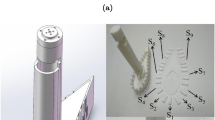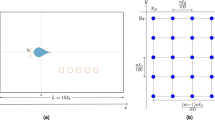Abstract
In nature, with the help of lateral lines, fish is capable of sensing the state of the flow field and recognizing the surrounding near-field hydrodynamic environment in the condition of weak light or even complete darkness. In order to study the application of lateral lines, an improved pressure distribution model was proposed in this paper, and the pressure distributions of the lateral line carrier under different working conditions were obtained using hydrodynamic simulations. Subsequently, a visualized pressure difference matrix was constructed to identify the flow fields under different working conditions. The role of the lateral lines was investigated from a visual image perspective. Instinct features of different flow velocities, flow angles and obstacle offset distances were mapped into the pressure difference matrix. Lastly, a four-layer Convolutional Neural Network (CNN) model was built as a recognition tool to evaluate the effectiveness of the pressure difference matrix method. The recognition results demonstrate that the CNN can identify the flow field state with 2 s earlier than the current time. Hence, the proposed method provides a new way to identify flow field information in engineering applications.
Similar content being viewed by others
References
McHenry M J, Liao J C. The Lateral Line System, Springer, New York, USA, 2013, 77–98.
Tuhtan J A, Fuentes-Perez J F, Toming G, Schneider M, Schwarzenberger R, Schletterer M, Kruusmaa M. Man-made flows from a fish’s perspective: Autonomous classification of turbulent fishway flows with field data collected using an artificial lateral line. Bioinspiration & Biomimetics, 2018, 13, 046006.
Bleckmann H, Zelick R. Lateral line system of fish. Inte-grative Zoology, 2009, 4, 13–25.
Coombs S, Hastings M, Finneran J. Modeling and measuring lateral line excitation patterns to changing dipole source locations. Journal of Comparative Physiology A, 1996, 178, 359–371.
Zheng X D, Zhang Y, Ji M J, Liu Y, Lin X, Qiu J, Liu G J. Underwater positioning based on an artificial lateral line and a generalized regression neural network. Journal of Bionic Engineering, 2018, 15, 883–893.
Montgomery J C, Baker C F, Carton A G. The lateral line can mediate rheotaxis in fish. Nature, 1997, 389, 960–963.
Chambers L D, Akanyeti O, Venturelli R, Jezov J, Brown J, Kruusmaa M, Fiorini P, Megill W M. A fish perspective: Detecting flow features while moving using an artificial lateral line in steady and unsteady flow. Journal of the Royal Society Interface, 2014, 11, 201467.
Goulet J, Engelmann J, Chagnaud B P, Franosch J M P, Suttner M D, van Hemmen J L. Object localization through the lateral line system of fish: Theory and experiment. Journal of Comparative Physiology A, 2008, 194, 1–17.
Abdulsadda A T, Tan X. Localization of a moving dipole source underwater using an artificial lateral line. Proceedings of SPIE - The International Society for Optical Engineering, Silicon Valley, USA, 2012, 8339, 833909.
Franosch V I, Audrey M, Frank M Y, Jason D, Jeffery H L, Michael S T. Lateral-line-inspired sensor arrays for navigation and object identification. Marine Technology Society Journal, 2011, 45, 130–146.
Franosch J M P, Sichert A B, Suttner M D, Hemmen J L. Estimating position and velocity of a submerged moving object by the clawed frog Xenopus and by fish - A cybernetic approach. Biological Cybernetics, 2005, 93, 231–238.
Liu G J, Gao S X, Sarkodie-Gyan T, Li Z X. A novel biomimetic sensor system for vibration source perception of autonomous underwater vehicles based on artificial lateral lines. Measurement Science and Technology, 2018, 29, 125102.
Abdulsadda A T, Tan X. Nonlinear estimation-based dipole source localization for artificial lateral line systems. Bioinspiration & Biomimetics, 2013, 8, 026005.
Yang Y, Nguyen N, Chen N, Lockwood M, Jones D L. Artificial lateral line with biomimetic neuromasts to emulate fish sensing. Bioinspiration & Biomimetics, 2010, 5, 16001.
Fan Z F, Chen J, Jun Z, Bullen D, Liu C, Delcomyn F. Design and fabrication of artificial lateral line flow sensors. Journal of Micromechanics and Microengineering, 2002, 12, 655–661.
Han Z W, Liu L P, Wang K J, Song H L, Chen D B, Wang Z, Niu S C, Zhang J Q, Ren L Q. Artificial hair-like sensors inspired from nature: A review. Journal of Bionic Engineering, 2018, 15, 409–434.
Chen N, Tucker C, Engel J M, Yang Y, Liu C. Design and characterization of artificial haircell sensor for flow sensing with ultrahigh velocity and angular sensitivity. Journal of Microelectromechanical Systems, 2007, 16, 999–1014.
Liu G J, Wang M M, Wang A Y, Wang S R, Yang T T, Malekian R, Li Z X. Research on flow field perception based on artificial lateral line sensor system. Sensors, 2018, 18, 838.
Klein A, Bleckmann H. Determination of object position, vortex shedding frequency and flow velocity using artificial lateral line canals. Beilstein Journal of Nanotechnology, 2011, 2, 276–283.
Chagnaud B P, Bleckmann H, Hofmann M H. Lateral line nerve fibers do not code bulk water flow direction in turbulent flow. Zoology, 2008, 111, 204–217.
Zhou H, Hu T J, Low K H, Shen L C, Ma Z W, Wang G M, Xu H J. Bio-inspired flow sensing and prediction for fish-like undulating locomotion: A CFD-aided approach. Journal of Bionic Engineering, 2015, 12, 406–417.
Chagnaud B P, Brucker C, Hofmann M H, Bleckmann H. Measuring flow velocity and flow direction by spatial and temporal analysis of flow fluctuations. Journal of Neuroscience, 2008, 28, 4479–4487.
Wolf B J, Morton J, Macpherson W N, Van N S M. Bio-inspired all-optical artificial neuromast for 2D flow sensing. Bioinspiration & Biomimetics, 2018, 13, 026013.
Jiang Y G, Fu J C, Zhang D Y, Zhao Y H. Investigation on the lateral line systems of two cavefish: Sinocyclocheilus macrophthalmus and S. microphthalmus (Cypriniformes: Cyprinidae). Journal of Bionic Engineering, 2016, 13, 108–114.
Tuhtan J A, Fuentes-Perez J F, Toming G, Kruusmaa M. Flow velocity estimation using a fish-shaped lateral line probe with product-moment correlation features and a neural network. Flow Measurement & Instrumentation, 2017, 54, 1–8.
Devries L, Lagor F D, Lei H, Tan X, Paley D A. Distributed flow estimation and closed-loop control of an underwater vehicle with a multi-modal artificial lateral line. Bioinspiration & Biomimetics, 2015, 10, 025002.
Ristroph L, Liao J C, Zhang J. Lateral line layout correlates with the differential hydrodynamic pressure on swimming fish. Physical Review Letters, 2015, 114, 018102.
Glowacz A. Fault diagnosis of single-phase induction motor based on acoustic signals. Mechanical Systems and Signal Processing, 2019, 117, 65–80.
Lecun Y L, Bottou L, Bengio Y, Haffner P. Gradient-based learning applied to document recognition. Proceedings of the IEEE, 1998, 86, 2278–2324.
Acknowledgment
This research was supported by the National Science Foundation of China (No. 61540010), Shandong Natural Science Foundation (No. ZR201709240210).
Author information
Authors and Affiliations
Corresponding author
Rights and permissions
About this article
Cite this article
Liu, G., Liu, S., Wang, S. et al. Research on Artificial Lateral Line Perception of Flow Field based on Pressure Difference Matrix. J Bionic Eng 16, 1007–1018 (2019). https://doi.org/10.1007/s42235-019-0113-5
Published:
Issue Date:
DOI: https://doi.org/10.1007/s42235-019-0113-5




